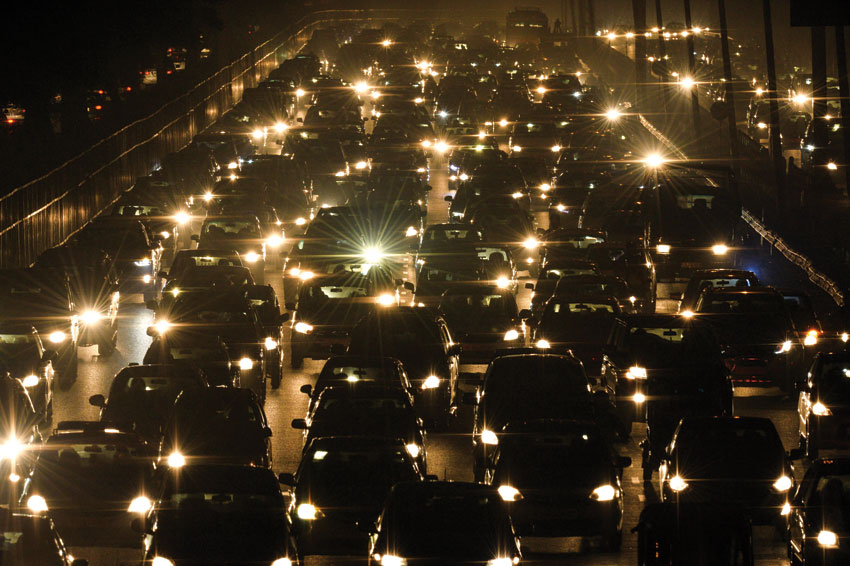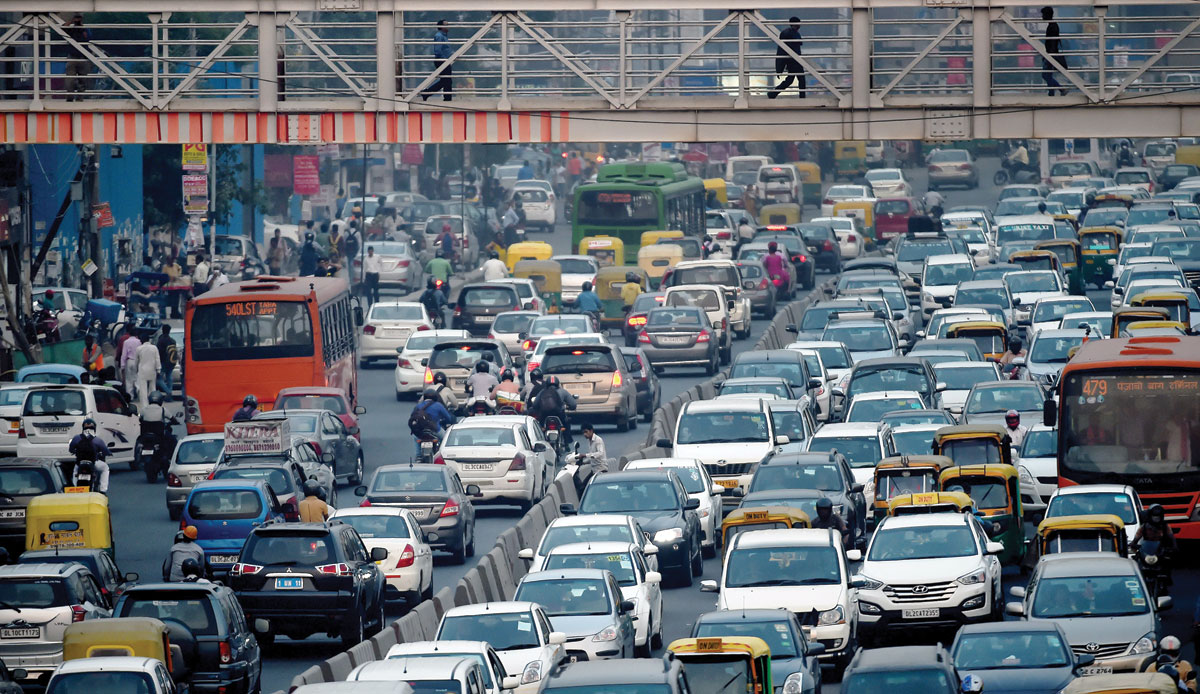MORE TRAFFIC JAMS
Commuters in their vehicles clog the roads of New Delhi. (Roberto Schmidt | AFP | Getty Images)
For the many who find India’s metros, cities and towns jammed with traffic, the bad news is that it will only get worse, writes Siddharth Srivastava. – @siliconeer #siliconeer #IndiaTrafficProblems #namo
India’s oil demand from April to June, the first three months of the financial year 2016-17, grew at the fastest pace for any first quarter period in the last decade. India consumed 48.5 million tons of oil products, which include petrol and diesel, in the quarter, which is an increase of 7.8% from the same period a year ago, according to the oil ministry’s Petroleum Planning and Analysis Cell.
That’s the quickest since the first quarter of the year ended March 2007. And this is when April-June is normally a poor period for oil demand in India due to pre-monsoon showers that reduces diesel consumption by agriculture, among other sectors.
Fuel consumption picks up during post-monsoons in the month of September. Last fiscal, for example, the first quarter demand growth stood at 6.6%, but for the entire fiscal year 2016, it went up 11% from a year earlier. Significantly, the growth in oil demand is not due to higher diesel use as is usual, but petrol, the fuel consumed by passenger vehicles. Underlining rise in household incomes, India’s consumption of gasoline soared 12.6% in the first six months of the year from 2015, growing at more than double the rate of China.
The overall petrol consumption at around 544,000 barrels per day is, however, less than a fifth of China’s. At the heart of rise in India’s gasoline usage is motorbikes that are a quick and fuel efficient mode of transport. About 16.5 million new units were sold in 2015-16, according to industry data, making India the world’s second biggest market after China, which sold 24.6 million motorbikes last year.
Given the trends, demand estimates for fuel consumption in India are robust. In a comment, Richard Mallinson, a geopolitical analyst at Energy Aspects, told Bloomberg, “We have seen acceleration in India’s oil demand as income levels improve and with infrastructure building picking up pace. India’s oil demand may grow by 400,000 barrels a day in 2016 and 2017 faster than any other country.”

The International Energy Agency (IEA), meanwhile, has projected that India will lead the world in oil demand and overtake Japan as the world’s third-largest oil user this year. “India will be the fastest-growing crude consumer in the world through 2040, adding 6 million barrels a day of demand, compared with 4.8 million for China,” Paris-based IEA has said. Over the longer term, IEA has estimated India’s fuel demand to scale 348 million tons by 2030 and further to 458 million tons by 2040, pegged to a modest 4% growth in consumption. New Delhi has taken cognizance of the developments. A government appointed expert panel has begun to prepare a blueprint to enhance India’s oil refining capacity by 2040 to meet future domestic fuel demand and possibly tap the export market further. A 12-member working group held its first meeting in July. In a statement, the oil ministry said an approach paper for long-term refinery capacity expansion needs to be prepared to meet the challenges ahead.
“India is one of the fastest developing countries in the world and simultaneously, the world energy demand is expected to double in the next 30 years with energy portfolio undergoing a transition to one that includes a wide range of sources,” the oil ministry said, adding, “It has been envisioned energy mix in 2040 could be entirely different from what it is today. New capacities in petroleum refining will depend upon aggregation of demand from different petroleum derived products, which itself depends upon substitution by other forms of energy and government policies.”
Global players, struggling to find new markets and reverse dipping revenues due to the oil and gas price crash are predictably taking notice of India’s exciting numbers. Last month India’s minister of oil and natural gas, Dharmendra Pradhan said oil and gas majors Saudi Aramco and Total of France have evinced interested in retailing fuel in India by setting up petrol pumps. Pradhan said UK’s BP could also take the plunge. Essar Oil, meanwhile, is working to complete a deal to sell a 49% stake in its Vadinar refinery to Russian giant Rosneft, who is keen to access the Indian market. European major Royal Dutch Shell has already announced plans to strengthen its existing fuel retail business. In the domestic sphere, India’s state-owned refiner, Indian Oil Corp (IOC), has announced plans to invest Rs. 400 billion to expand its refining capacity. An official at IOC said, “Our focus is domestic demand as the projections of fuel needs are very clear for India.”
There are many who believe the only way to arrest India’s fuel guzzling ways, is to build efficient transport infrastructure, both bus and rail, in the country. This, however, is not going to happen in a hurry given India’s poor record at implementing public projects. Till then, it will be best to prepared for the worst — long never-ending traffic jams that are only going to get worse.


